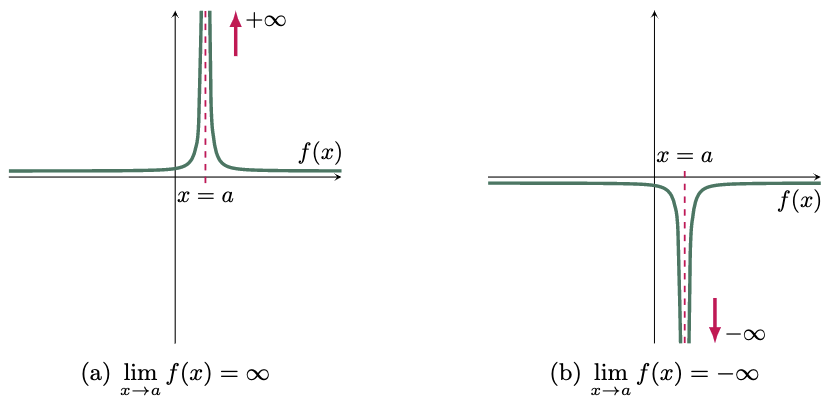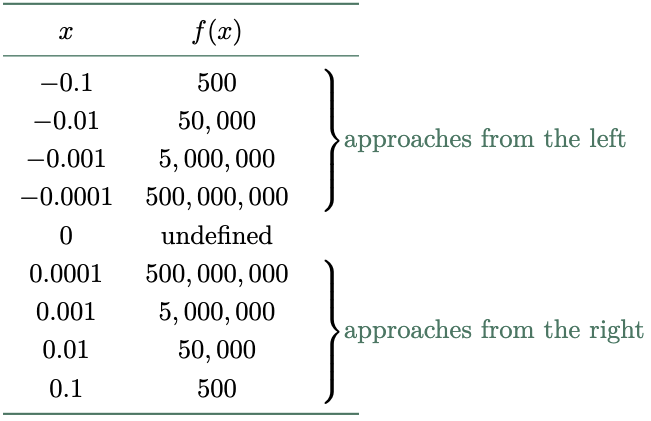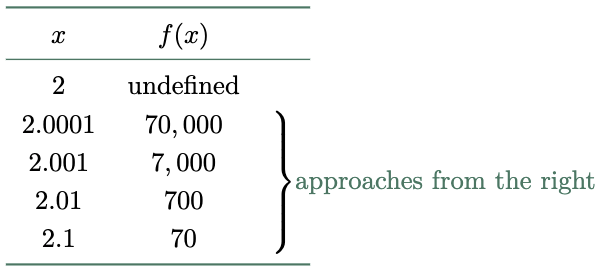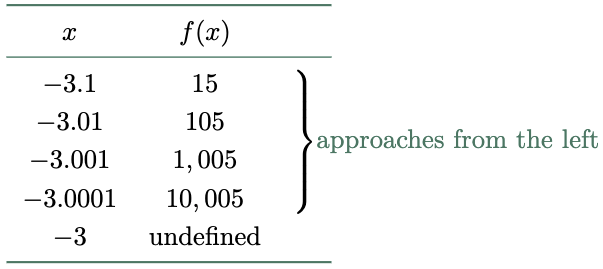If you recall our lecture on Limits at Infinity, we used a pizza to depict its size after being sliced into an infinite number of pieces. Here, it is absolutely the opposite. The question that we are now attempting to answer is “how many slices can there be if each slice has a size approaching to nothing (zero).” As you may anticipate, the answer would be “infinity.”
Infinite Limits are those with a limit that approaches infinity in either direction. The limit that approaches infinity “$\infty$” means that as $x$ approaches $a$, the function gets larger and larger where it increases without bound ($\eref{eq:infinite limits 1}$). On the other hand, the limit is approaching negative infinity “$-\infty$” as $x$ approaches $a$ if the function decreases without bound ($\eref{eq:infinite limits 2}$).
$$\begin{align} \lim_{x\to a}f(x)=\infty \label{eq:infinite limits 1} \\ \lim_{x\to a}f(x)=-\infty \label{eq:infinite limits 2} \end{align}$$
If we illustrate this concept graphically, the graph of a function with Infinite limits contains Vertical Asymptotes; for example, in Figure 1, the function has an asymptote at $x=a$. The curve approaches the line $x=a$ without touching it. Vertical asymptotes occur where the function becomes undefined, given that the limit approaches positive or negative infinity.
In relation to Limits at Infinity, the graph has Horizontal Asymptotes when the function approaches infinity.

Figure 1: Vertical asymptotes at $x=a$ of infinite limits
$\example{1}$ Evaluate $\lim_{x\to 0} \frac{1}{x}$
$\solution$
By substituting $x$ in the function with 0, we would get $\frac{1}{0}$ which is undefined. However, let us try to substitute a value for $x$ that approaches zero from either side and try to see what value the function is approaching.

As you can see, the value is getting larger and larger as $x$ approaches zero. Thus, the function is not approaching a certain value but to infinity. In this case, the right hand-limit is approaching to positive infinity,
\[\lim_{x\to 0^+} \frac{1}{x} = \infty\]And the left-hand limit is approaching negative infinity.
\[\lim_{x\to 0^-} \frac{1}{x} = -\infty\]Since the left and right hand limits do not approach the same value, the limit as $x$ approaches $0$ does not exist.
\[\begin{align*} \lim_{x\to 0^-} &\neq \lim_{x\to 0^+} \\ \lim_{x\to 0} \frac{1}{x} &= \mathrm{DNE} \tagans \end{align*}\]$\example{2}$ Evaluate $\lim_{x\to 0} \frac{5}{x^2}$
$\solution$
Substitute values to $x$ approaching 0 from both sides.

The left and right hand limits both approaches to infinity as $x$ approaches 0. Hence,
\[\begin{align*} % \lim_{x\to 0^-} &= \lim_{x\to 0^+} \\ \lim_{x\to 0} &= \infty \tagans \end{align*}\]$\example{3}$ Evaluate $\lim_{x\to 2^+} \frac{7}{x-2}$
$\solution$
In this example, we are only asked to determine the right-hand limit of the function. So, substitute values to $x$ approaching 2 from the right.

Since the function is getting larger and larger as $x$ approaches 2 from the right,
\[\begin{align*} \lim_{x\to 2^+} \frac{7}{x-2} &= \infty \tagans \end{align*}\]$\example{4}$ Evaluate $\lim_{x\to -3^-} \br{ 5-\frac{1}{x+3} }$
$\solution$
In this example, we are only asked to determine the left-hand limit of the function. So, substitute values to $x$ approaching $-3$ from the left.

Since the function is getting larger and larger as $x$ approaches $-3$ from the left,
\[\begin{align*} \lim_{x\to -3^-} \br{ 5-\frac{1}{x+3} } &= \infty \tagans \end{align*}\]
